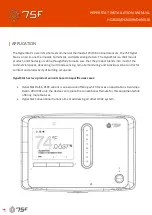
Vane Damper
FYN-S 1 Series
*Max.angle
* Operating temperature
* Weight
* Main body material
* Cap material
* Rotor material
* Oil type
130"
-S~SO"C
220±10g
Zinc die-cast (ZDC)
Zinc die-cast (ZDC)
Polyacetal (POM)
Silicone oil
I
How to Use the Damper
I
Specifications
Model
Max. torque
Reverse
torque
Damping direction
FYN-51-R104
10N·m
1.5 N·m or lower
Clockwise
-------------------------------
FYN-51-L104
(100 kgf·cm)
( 15 kgf·cm or lower)
Counter-clockwise
Note) Measured at 23' C ± 2' C
5
(5)
3.5
1. Operating characteristics of self-adjusting oil pressure dampers
In a conventional vane damper. the damping strength (damping constant) does not change regardless of the load torque used. Because
of this, its working speed is slower when the load torque is small, and faster when the load torque is large. However, because the self
adjusting FYN-51 series is designed to self-adjust the damping force (damping constant) according to the applied load. the working speed
fluctuates less compared to conventional dampers when the applied load is altered. The acceptable range or torque is 5 ~1 0N·m. Please
select your damper by referring to the motion-time graph below.
Valve (Flat spring)
[Motion time graph]
7.5
10
Load torque[N·m]
(Operating principles of the self-adjusting type]
As shown in the diagram to the left. by changing the shape of the valve (flat spring). the
amount of oil flow is altered. adjusting the damper's generated torque. (PAT.Pl
(Measurement conditions for th e motion-time graph]
90'
• Load torque T s·1 0N·m
• Measured angle 30" ~ -30"
• Measurement temperature 23" C±2
°
C
As the level of self-adjustment may vary
depending on the range of the working angle
of the actual work, please verify under actual
working conditions before you select your
damper.





























